Key takeaways:
- Analyzing bestselling trends reveals how societal events influence reading choices and the importance of reader reviews in building community connections.
- Understanding trends is essential for aligning inventory with reader interests, fostering loyalty, and curating diverse, relevant content.
- Utilizing tools like Google Trends, social media analytics, and customer feedback enhances trend analysis, creating a more engaging relationship with readers.
- Implementing insights from trend analysis into sales strategies, such as personalized recommendations and adjusting inventory, can significantly boost sales and customer engagement.
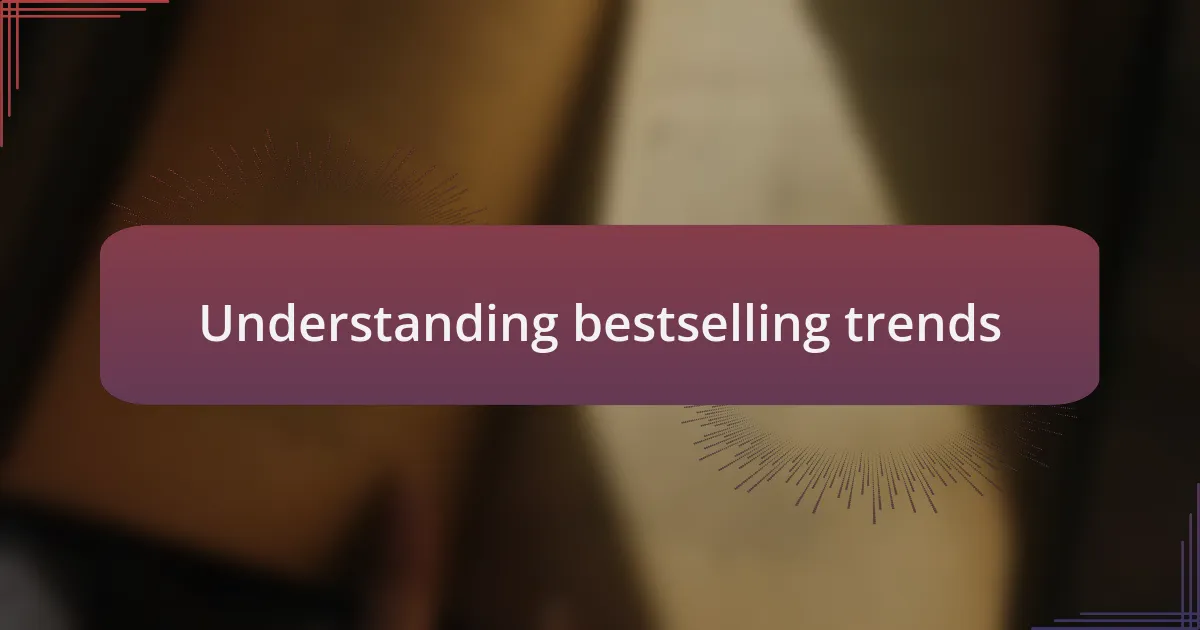
Understanding bestselling trends
Understanding bestselling trends is all about analyzing what resonates with readers. I remember the first time I spotted a pattern where books tied to current events surged in sales. It made me realize how closely intertwined our reading choices are with societal shifts and collective emotions. This connection fuels our curiosity—doesn’t it make you wonder how a single event can ignite an entire genre?
Another point that often stands out to me is the role of reader reviews. When I delve into bestselling lists, I often look at the feedback from readers, not just the star ratings. Some reviews are more than mere opinions; they reveal deeper cravings for connection or understanding. Have you noticed how a touching story can evoke a flood of personal experiences in the comments section? It’s fascinating how sharing a book can create a community of voices.
Moreover, timing plays a pivotal role in identifying trends. I recall observing a notable spike in young adult novels during the summer months. It’s as if readers unconsciously gravitate towards specific genres depending on the season or even holidays. Isn’t it intriguing to think how our choices might change based on the time of year? It really shows that understanding these trends requires a keen eye on the calendar and emotional landscapes.
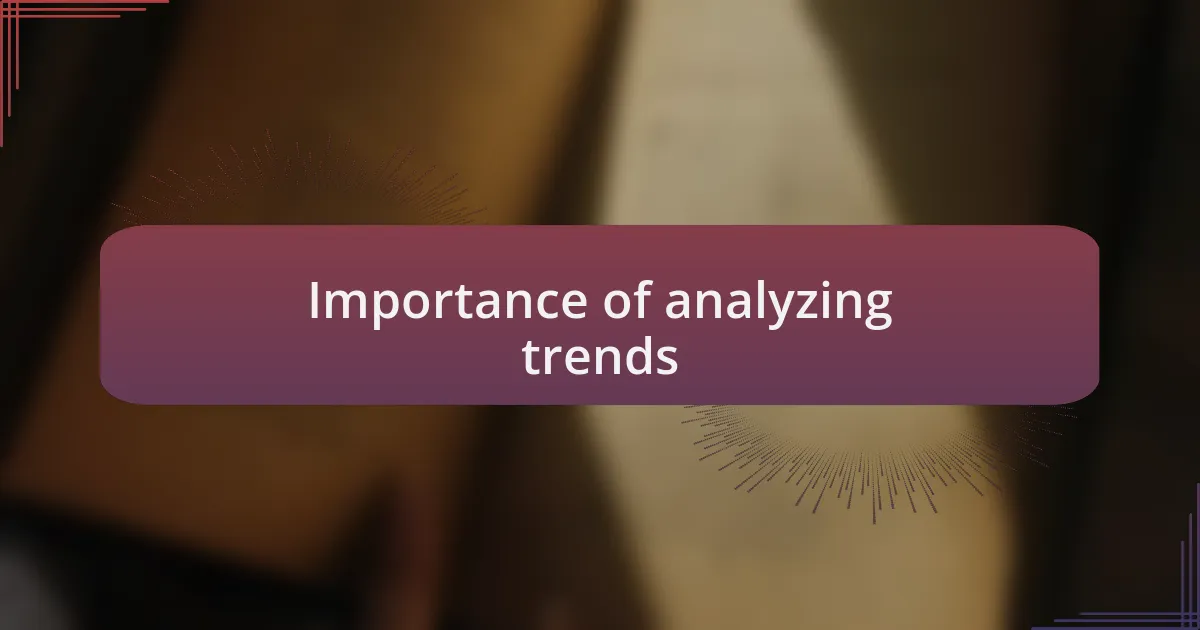
Importance of analyzing trends
Analyzing trends in the literary market is crucial because it helps us connect with readers on a profound level. I remember when I first adjusted my book recommendations based on emerging trends, and the feedback was incredibly rewarding. It’s remarkable how readers appreciate when their current moods and interests align with what’s available on the shelves. Can you imagine how satisfying it is to offer a book that perfectly matches someone’s state of mind?
Moreover, understanding trends can empower us to make informed purchasing decisions, which is vital for any online bookstore. When I noticed a growing interest in self-help books, I decided to stock more titles in that genre. Surprisingly, sales soared! It’s clear that responding to market trends not only boosts sales but also fosters loyalty among readers who feel understood and catered to.
Additionally, interpreting trends can guide us in curating diverse and relevant content that reflects the evolving tastes of our audience. Just last year, I saw an uptick in demand for diverse voices in literature. Taking note of this shift, I made an effort to highlight underrepresented authors in our monthly features. Isn’t it fulfilling to see readers discover new perspectives that resonate with their experiences? By staying attuned to these trends, we become more than just booksellers; we transform into valuable resources for our community.
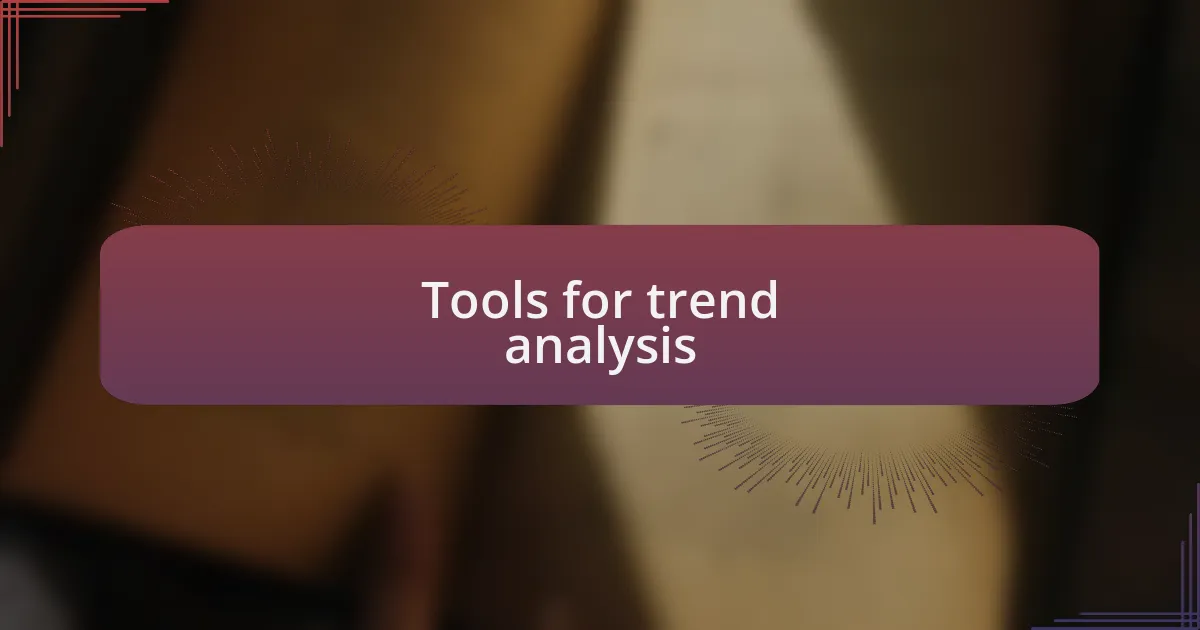
Tools for trend analysis
To effectively analyze trends in the literary market, I rely heavily on a few key tools. One such tool is Google Trends, which provides real-time data on what readers are searching for. I found it fascinating when a spike in interest for psychological thrillers appeared, guiding my next inventory decisions and helping me create book bundles that captured that interest. Isn’t it intriguing how a simple online tool can have such a direct impact on our offerings?
Another resource that I frequently turn to is social media analytics. Platforms like Twitter and Instagram serve as a pulse-check for what readers are buzzing about. I recall a time when a particular book meme took off, leading me to explore that genre more deeply. It’s thrilling to delve into conversations that shape reader preferences—don’t you love being part of those discussions?
Lastly, I can’t overlook the power of customer feedback tools, such as surveys and reviews. Engaging directly with customers not only gauges their preferences but also builds a sense of community. For instance, after implementing a quick survey about upcoming genres, I was pleasantly surprised by requests for graphic novels, which was an area I had overlooked. Isn’t it rewarding to align our offerings with the voices of our readers? By embracing these diverse tools, trend analysis becomes not just a data-driven exercise but a richer, more personal engagement with our audience.
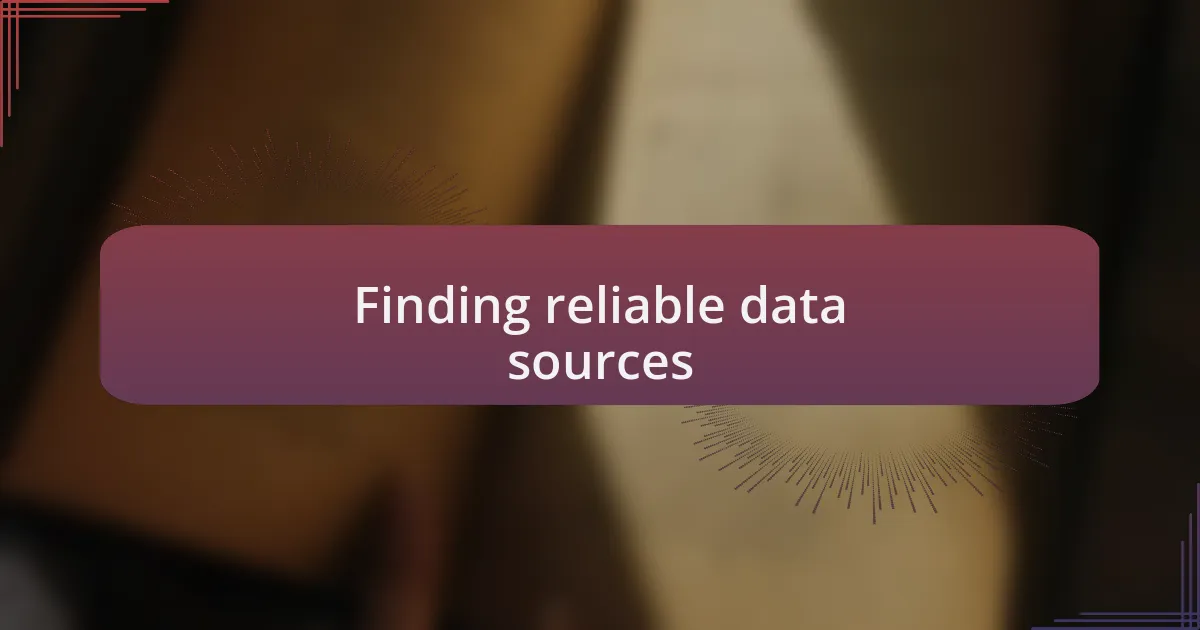
Finding reliable data sources
Finding reliable data sources is essential for any trend analysis in the book market. One of my go-to sources is Nielsen BookScan, which tracks book sales across various formats and retailers. I remember the thrill of uncovering real sales figures for a niche genre I was considering; it transformed my approach and led to strategic inventory changes. Have you ever felt that rush of clarity when you stumble upon vital information?
Another valuable data source is industry reports from organizations like the American Booksellers Association. Diving into these reports can reveal broader market trends and consumer behavior patterns. I often find myself jotting down insights that seem mundane at first but later unfold into significant strategies. It’s amazing how understanding the bigger picture can influence small, everyday decisions.
I also turn to academic publications and research studies that examine reading habits and preferences. This might seem unexpected, but often these studies illuminate long-term trends that aren’t apparent in quick analyses. Reflecting on a study I read about digital reading habits, I felt compelled to shift my focus toward e-books, which eventually led to noticeable growth in my online sales. Isn’t it enlightening how academic insights can shape our practical business strategies?

Techniques for identifying patterns
When it comes to identifying patterns, I often start by analyzing customer reviews and ratings on various platforms. I recall diving headfirst into a collection of reviews for a bestselling thriller, noticing recurring themes in what readers loved or found disappointing. These little nuggets of insight can guide my purchasing decisions, as they highlight not just preferences, but the emotional connections people have with the narratives. Have you ever wondered how much you can learn from just a few sentences written by your customers?
Another effective technique is using social media analytics to track discussions around particular titles or genres. Recently, I observed a spike in chatter about self-help books focusing on mental wellness. It reminded me how invaluable these platforms can be: they not only show what’s trending but also indicate shifting sentiments in real-time. It’s fascinating to see how conversations evolve, revealing underlying consumer desires that books can fulfill. Have you ever followed a hashtag and felt inspired by the collective enthusiasm it generated?
Lastly, I like to employ comparative analysis by looking at sales data over various time frames. By examining sales trends month over month, I discovered that certain genres, like historical fiction, tend to peak during specific seasons. This pattern guided my seasonal promotions last year, effectively boosting my revenue during those key times. Isn’t it remarkable how a simple change in perspective can uncover hidden opportunities in what’s often perceived as routine data?

Personal insights from my experience
When I reflect on my experience with analyzing bestselling trends, I often think about the importance of intuition paired with data. I once had a hunch about a particular genre that didn’t seem to fit the usual mold—literary fiction. I delved into discussions on forums and noticed how passionate readers were about works that pushed boundaries subtly. Did you ever have a feeling about a book before even cracking it open? That gut instinct can be a powerful tool, guiding my research in unexpected directions.
Navigating the world of online bookstores has taught me that empathy truly matters. For instance, during my analysis of young adult fiction, I stumbled upon heartfelt blog posts from teenagers discussing how characters impacted their lives. It was a profound moment for me; realizing that these narratives could transform experiences and emotions. Have you ever paused to consider how a book connects with someone’s personal journey? That realization fueled my enthusiasm to curate selections that resonate deeply.
I find that collaboration enhances my insights, especially in a team setting where ideas flow freely. Engaging with fellow book lovers often leads to unexpected perspectives. Recently, discussing emerging authors with a colleague opened my eyes to voices I had overlooked. Conversations like these make me wonder how many hidden gems are out there just waiting to be discovered. Isn’t it amazing how teamwork can ignite new ideas and insights?
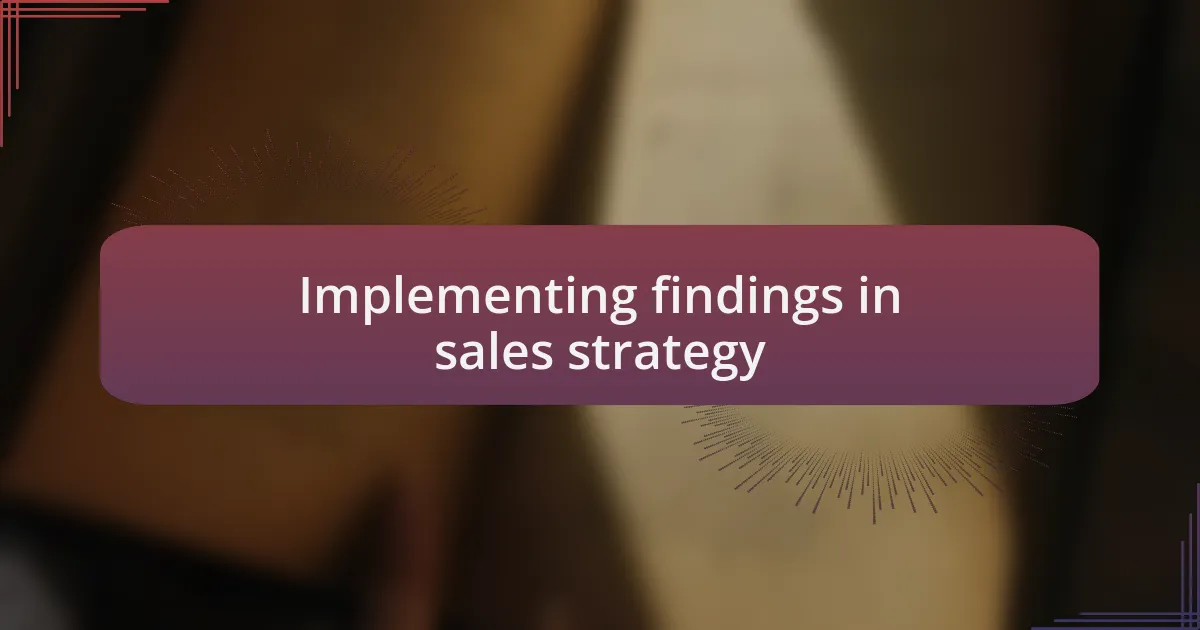
Implementing findings in sales strategy
Implementing findings from my analysis into our sales strategy has been quite a journey. For instance, after identifying a surge in popularity for graphic novels, I worked with the marketing team to create targeted promotions that highlighted this genre. Seeing those tailored campaigns translate into increased sales was a rewarding reminder of how well our insights can shape strategy. Have you ever watched a marketing idea come to life and felt that rush of excitement as results start to roll in?
It’s also vital to be flexible in adjusting our approach based on what the data reveals. I recall a time when we noticed a significant interest in historical fiction during a specific season. We quickly pivoted our inventory choices and events to match this trend, resulting in a surge in sales and customer engagement. Isn’t it fascinating how quickly shifting gears can lead not only to better sales but also to deeper connections with our readers?
Moreover, connecting with our audience through personalized recommendations has proven invaluable. By utilizing insights on individual customer preferences, we crafted experiences that resonate on a personal level. One time, I received feedback from a reader who felt genuinely understood through our curated list—it made me realize that sales strategies rooted in empathy can transform a simple transaction into meaningful connections. How often do we overlook the human side of sales?